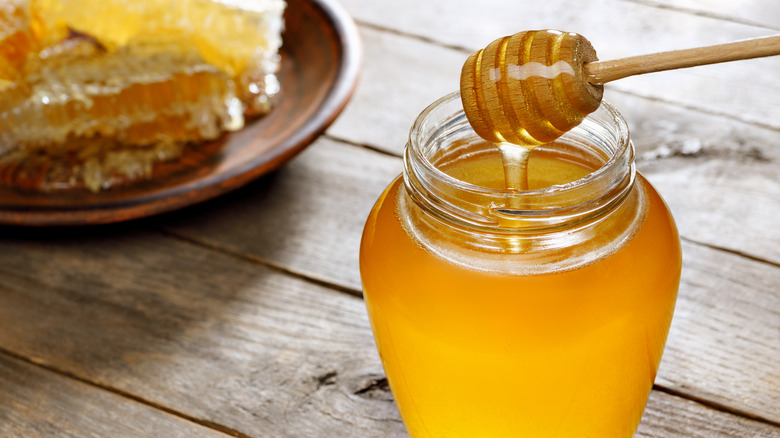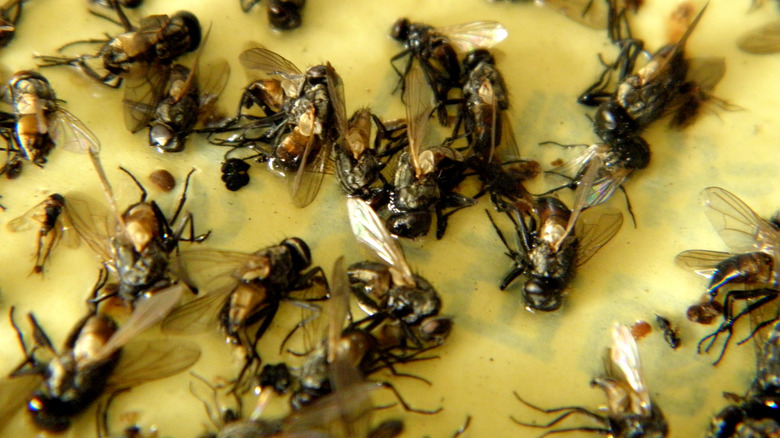Can You Really Use Honey To Trap Pesky Flies?
We may receive a commission on purchases made from links.
When it comes to household annoyances, few pests rival the ubiquitous and persistent housefly. In fact, flies, in general, are a perennial problem around the world, with over 120,000 species scattered across the continents. Whether drawn to food, garbage, or the warmth they seek, these winged invaders seem to have an uncanny ability to infiltrate our living spaces. Their incessant buzzing and seemingly erratic flight patterns can turn any serene day into a battle against a fast-moving foe. And they're not just a summertime woe; they persist year-round, making eradicating them an ongoing concern for homeowners.
In the quest to rid homes of these pests, people have explored various methods of fly removal, ranging from traditional fly swatters to sophisticated electronic traps. For those of us less inclined to chase around a pesky fly every time one appears, a common DIY fly control method uses honey to trap and eliminate them. But is honey truly effective in luring and catching these bothersome insects? Our answer: Yes. However, it may be better thought of as a temporary solution — one that should be combined with other fly prevention or removal methods for more thorough results.
Using honey in fly traps
Honey is known for its natural sweetness and gooey consistency — qualities that make it a common ingredient in DIY fly traps. One simple fly trapping method involves placing jars with a generous dollop of honey mixed with a little water in strategic locations. Another common DIY fly trap uses a large, empty plastic bottle cut in half. The top half of the bottle — inverted to form a funnel — guides flies into the trap, the inside of which is coated with honey or syrup. The idea is simple: Flies are drawn in by the aroma of the honey, only to find themselves ensnared in the sticky substance. Those who manage to escape this fate at first tend to be stumped by the small opening of the bottle's neck, trapping them inside the plastic container.
There are also commercially available fly traps requiring the addition of an attractant like honey, including Trappify Hanging Fly Traps (retailing on Amazon at $22.99 for a pack of four) and the Raid Fly Stick that costs $2.97 per pack at Walmart — both highly rated at an average 4-star mark. These traps combine the sweetness of honey with other ingredients, creating a potent mix that proves irresistible to flies. Similar to bees, flies are drawn to sugary substances and will even return to areas where they have encountered a sweet morsel before — meaning a stationary honey trap can give you another shot at a fly that might have escaped once before.
Disadvantages and alternatives to honey fly traps
While DIY fly traps using honey may work, the sticky nature of the substance can present challenges. Cleaning up honey-laden traps can be a messy affair, and the residue left behind may attract more pests or become a breeding ground for bacteria (even if the honey itself thwarts most germs, per the National Institutes of Health). So while honey can be a potent lure, you need to decide if the resulting cleanup is a worthwhile trade-off for a fly-free living space.
At best, you can treat honey-laced fly traps as a temporary solution — as with other pests, a comprehensive approach in the form of integrated pest management often works best. To prevent flies from entering your home, install screens on windows and doors or always keep entry points closed so flies will be less able to access food sources. Beyond utilizing sweet traps, regular and thorough cleaning, particularly of kitchens and disposal areas, also significantly reduces the attraction for these pests.
Sealing food containers and promptly disposing of garbage are fundamental steps in fly prevention; the elimination of potential breeding sites, such as stagnant water or organic waste, is equally important. For those flies that manage to find their way inside anyway, consider keeping some of their natural predators around, such as spiders or carnivorous plants. Other chemical-free alternatives include fly traps employing apple cider vinegar or repellents containing essential oils, which can prove effective without the sticky aftermath associated with honey-based traps.


